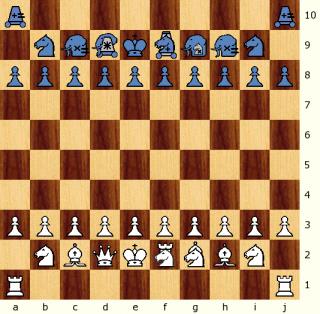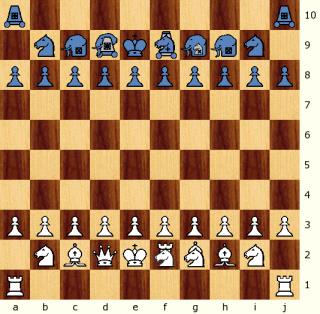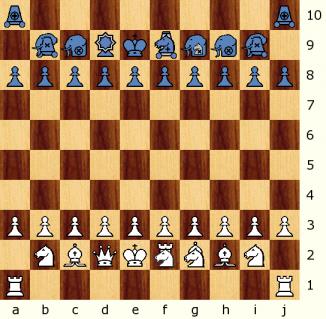Grand CwDA: the Shatranjians
Grand Chess with Different Armies: The Shatranjians
Western chess and chess variants tend to concentrate on long range pieces, or pieces with an unlimited slider [bishop, rook] component. Eastern games use more limited short range pieces that are weaker in general than the Western pieces. A major exception to this trend in Western chess variants has been Ralph Betza's Chess with Different Armies forces, which feature many unusual short and medium range pieces. But short range pieces never quite went away. They have always been around. Some have even shared the spotlight with the more traditional variant pieces in games. But few have built armies all of short range pieces, Pizza Kings by John Lawson being a notable exception, and there are others.A minority opinion holds that short range pieces can do very well on larger boards. This opinion has led to sometimes lively discussion. Following are some weapons perfectly suitable for both sides to use in the argument.
Setup

Grand Chess vs Grand Shatranj

Grand Chess vs The Shatranjian Shooters

Grand Chess vs Grand Lemurian Shatranj
Pieces
The standard Grand Chess pieces are used, but not listed, as this is overlong already. All pawns are modern, with double initial first step and the ability to capture en passant.Grand Shatranj
 Jumping general. Moves as the elephant or
dababba. It may move 1 square or leap 2 squares orthogonally or
diagonally.
Jumping general. Moves as the elephant or
dababba. It may move 1 square or leap 2 squares orthogonally or
diagonally.
 Minister. Moves like the knight, dababbah,
or wazir. It slides 1 or jumps 2 squares orthogonally, or jumps
in the standard knight's "L".
Minister. Moves like the knight, dababbah,
or wazir. It slides 1 or jumps 2 squares orthogonally, or jumps
in the standard knight's "L".
 High priestess. Moves like the knight,
alfil, or ferz. It slides 1 or jumps 2 squares diagonally, or
jumps in the standard knight's "L".
High priestess. Moves like the knight,
alfil, or ferz. It slides 1 or jumps 2 squares diagonally, or
jumps in the standard knight's "L".
 Oliphant, a double elephantrider. Moves
twice as an alfil or ferz. It slides 1 or jumps 2 squares
diagonally, and then may do either again. Thus it may move 1, 2, 3, or 4 squares. It must move in a straight line.
Oliphant, a double elephantrider. Moves
twice as an alfil or ferz. It slides 1 or jumps 2 squares
diagonally, and then may do either again. Thus it may move 1, 2, 3, or 4 squares. It must move in a straight line.
![]() kNight. This is the standard chess knight,
jumping 2 squares, one orthogonally and the second diagonally
outward.
kNight. This is the standard chess knight,
jumping 2 squares, one orthogonally and the second diagonally
outward.
 Lightning warmachine, a double
dababbarider. Moves twice as a dabbabah or wazir. It slides 1 or
jumps 2 squares orthogonally, then may do either again. It also can move 1, 2, 3 or 4 squares. It must move in a straight line.
Lightning warmachine, a double
dababbarider. Moves twice as a dabbabah or wazir. It slides 1 or
jumps 2 squares orthogonally, then may do either again. It also can move 1, 2, 3 or 4 squares. It must move in a straight line.
Shatranjian Shooters
 WarElephant - The WarElephant may move as
either as either the Hero or Shaman. It may step one square, leap
two squares, or do both, in either order, in either an orthogonal
or diagonal direction. It moves in a straight line; it may not
change directions during a turn. It captures by replacement,
stopping and ending its turn on the square of the piece captured.
WarElephant - The WarElephant may move as
either as either the Hero or Shaman. It may step one square, leap
two squares, or do both, in either order, in either an orthogonal
or diagonal direction. It moves in a straight line; it may not
change directions during a turn. It captures by replacement,
stopping and ending its turn on the square of the piece captured.
 H - the Hero. It may move 1, 2, or 3 squares in a turn. This piece is a combination of wazir and dabbabah, able to move orthogonally only, in a straight line only, as either or both. When activated, it may slide 1; or jump 2; or slide 1 and jump 2; or jump 2 and slide 1, horizontally or vertically only.
H - the Hero. It may move 1, 2, or 3 squares in a turn. This piece is a combination of wazir and dabbabah, able to move orthogonally only, in a straight line only, as either or both. When activated, it may slide 1; or jump 2; or slide 1 and jump 2; or jump 2 and slide 1, horizontally or vertically only.
 S - the Shaman. This is the diagonal analog of the Hero. It slides 1 and/or jumps 2 in a diagonal line. This piece is a linear mover. It may not change directions during its move.
S - the Shaman. This is the diagonal analog of the Hero. It slides 1 and/or jumps 2 in a diagonal line. This piece is a linear mover. It may not change directions during its move.
Lemurian Grand Shatranj
 Sliding General - This piece is a combination of 2 guards. It slides 1 or 2 squares. It may not jump. It may change direction during its move. It may not make a null move [move off and then back onto its starting square]. It captures by landing directly on an opposing piece and ending its turn.
Sliding General - This piece is a combination of 2 guards. It slides 1 or 2 squares. It may not jump. It may change direction during its move. It may not make a null move [move off and then back onto its starting square]. It captures by landing directly on an opposing piece and ending its turn.
 Bent Shaman - This piece is a combination of alfil and ferz. It may step 1 square diagonally and/or jump 2 squares diagonally, for a maximum of 3 squares moved per turn. It may: step 1 square; or jump 2 squares; or step 1 and jump 2 squares; or jump 2 squares then step 1 more square, always diagonally. It may change direction during its move. It captures by landing directly on an opposing piece and ending its turn. This is a colorbound piece.
Bent Shaman - This piece is a combination of alfil and ferz. It may step 1 square diagonally and/or jump 2 squares diagonally, for a maximum of 3 squares moved per turn. It may: step 1 square; or jump 2 squares; or step 1 and jump 2 squares; or jump 2 squares then step 1 more square, always diagonally. It may change direction during its move. It captures by landing directly on an opposing piece and ending its turn. This is a colorbound piece.
 Bent Hero - This piece is a combination of dabbabah and wazir. It steps 1 square orthogonally and or jumps 2 squares orthogonally, for a maximum of 3 squares per turn. It may: step 1 square; or jump 2 squares; or step 1 and jump 2 squares; or jump 2 squares then step 1 more square, always orthogonally. It may change direction during its move. It captures by landing directly on an opposing piece and ending its turn.
Bent Hero - This piece is a combination of dabbabah and wazir. It steps 1 square orthogonally and or jumps 2 squares orthogonally, for a maximum of 3 squares per turn. It may: step 1 square; or jump 2 squares; or step 1 and jump 2 squares; or jump 2 squares then step 1 more square, always orthogonally. It may change direction during its move. It captures by landing directly on an opposing piece and ending its turn.
 War Elephant - This is a combination of ferz, alfil, and dabbabah. It may move 1 square diagonally; or jump 2 squares either orthogonally or diagonally. It captures by landing directly on an opposing piece and ending its turn. This is a colorbound piece.
War Elephant - This is a combination of ferz, alfil, and dabbabah. It may move 1 square diagonally; or jump 2 squares either orthogonally or diagonally. It captures by landing directly on an opposing piece and ending its turn. This is a colorbound piece.
Rules
Except for specific variant piece movement, all rules are as in standard Western {FIDE] chess.The Shatranjians are always presented as Black in the presets. However, the presets allow a player to pass [type 'pass' in the MOVE box] so the Shatranjians may move first if desired.
Notes
I'd like to thank Abdul-Rahman Sibahi, Christine Bagley-Jones, and David Paulowich for helping this series get designed. HG Muller and Jeremy Good were also involved more peripherally. And I especially thank all those who encouraged me to do this originally, by doubting short range pieces are capable of standing up to modern Western pieces.I thank Christian Freeling for his kind permission to use the "Grand" name and set-up in Grand Shatranj.
I thank Steven Streetman for the 2 immediate inspirations for this page: his excellent recent posting of the CwDA Spartan Chess; and his gracious offer to write a guide for game [and other] submissions.
Abdul-Rahman Sibahi had the original idea for a shatranj CwDA, and asked me to work with him, resulting in the original 2007 post of CwDA: The Shatranjian Shooters
http://www.chessvariants.org/index/msdisplay.php?itemid=MScwda:theshatra
 This 'user submitted' page is a collaboration between the posting user and the Chess Variant Pages. Registered contributors to the Chess Variant Pages have the ability to post their own works, subject to review and editing by the Chess Variant Pages Editorial Staff.
This 'user submitted' page is a collaboration between the posting user and the Chess Variant Pages. Registered contributors to the Chess Variant Pages have the ability to post their own works, subject to review and editing by the Chess Variant Pages Editorial Staff.
By Joe Joyce.
Web page created: 2010-11-10. Web page last updated: 2010-11-10
